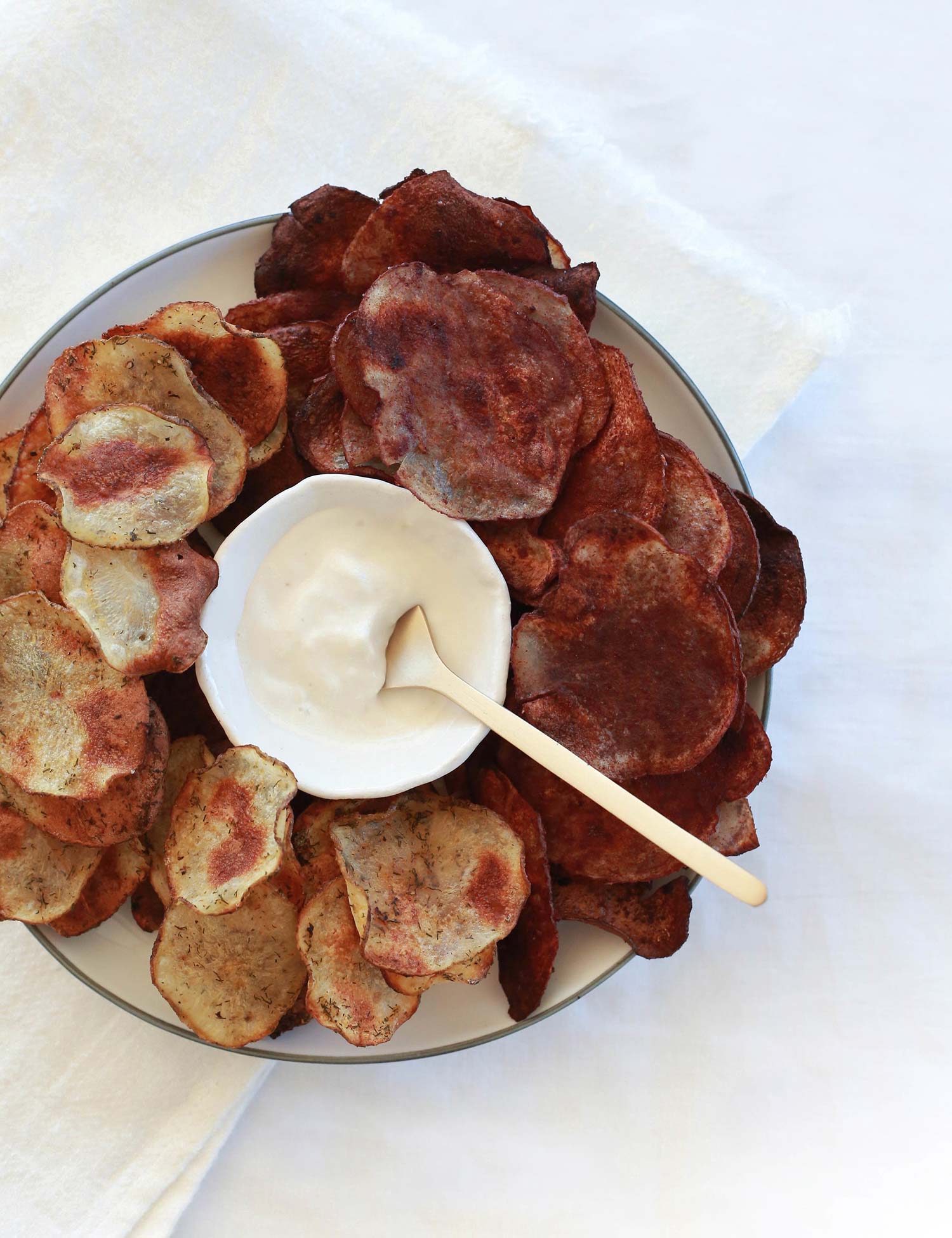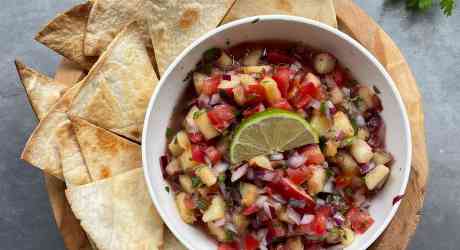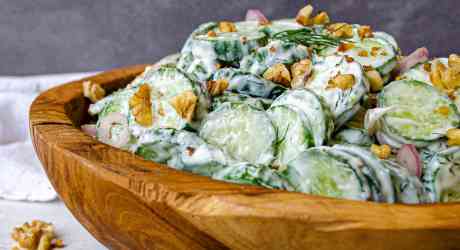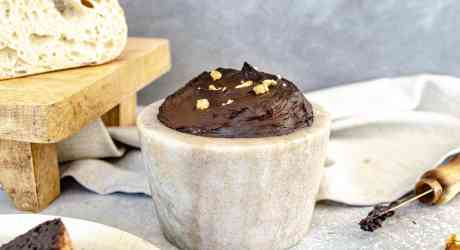Homemade Potato Chips - 2 Ways

Do you ever crave junk food when you are stressed and exhausted? Or maybe when you feel irritable, moody, lethargic and can’t concentrate? Don’t worry, you're not alone...this is a totally typical biological response to stress. But let’s be real for a second, just because it’s "typical" doesn’t mean you (or anyone else) should feel like this. Why do cravings happen? More importantly, what can you do to stop them? And perhaps most importantly (and our challenge for this recipe), can you stop craving junk food while eating the very junk food that you’re craving? Yes, you can! Keep reading to learn the science behind why our potato chip recipe CAN help you kick your cravings!
When we are under stress, our brain needs more energy than usual to function. And carbohydrates (specifically the glucose from when carbs are metabolized) are our brain’s preferred source of energy. In order to meet this increased demand in energy, our adrenal glands release cortisol and adrenaline.
Cortisol is our main stress hormone and it plays two key roles when we are under stress. One, it increases our blood glucose (sugar) levels; and two, it activates our brain’s feeding centre to replenish the glucose stores that were used up. Adrenaline is also a stress hormone and its duty is to ensure the glucose reaches our brain. Together, they ensure our brain receives sufficient energy when we are under stress, so we can continue with our business.
Because our brain (and body) needs carbohydrates, when cortisol pokes and prods at our feeding centre, we are actually biologically programmed to crave carbohydrate-rich foods. If these cravings are ignored, well, you can guarantee yourself a front row seat on the blood sugar rollercoaster. When our blood sugar levels are not replenished, we enter a state of hypoglycemia (low blood sugar) and neuroglycopenia (low brain sugar). This is then when we feel irritable, emotional, lethargic, poor cognitive function, shaky, and dizzy. This classic “hangry” increases our risk for insulin resistance and type two diabetes in the long-term.
Good news: when we replenish our blood sugar levels, the blood sugar rollercoaster symptoms will disappear. Bad news: if we don’t eat the right type of carbohydrates, and instead eat junk food, it can actually create an association in the brain that junk food makes us feel better — which is how emotional eating can become a coping mechanism. The connection between eating junk food and feeling better, albeit only temporarily, is a very strong one. We work with A LOT of clients who eat emotionally. And we understand that emotional eating is multi-faceted and has psychological, emotional and spiritual causes too. But within our scope, we work to balance clients’ blood and brain sugar to get them off the blood sugar rollercoaster using neuro-nutrition. When we can get blood sugar into a healthy, happy zone we can curb the neuro-biologicial side of emotional eating, and clients notice that their cravings nicely subside.
So, how do we use neuro-nutrition to help fight cravings? First, we don’t believe in denying yourself when you’re craving. We want you to be able to have those cookies or mac n’ cheese, or yes, even potato chips! But, we want you to have those foods in a way that actually supports blood sugar balance. We do that by brain hacking recipes and using smarter ingredients. Wondering how we made these potato chips healthier? Keep reading to learn about key ingredients.
You can use a regular potato (the other ingredients will still balance blood sugar), but we definitely prefer sweet potatoes. Sweet potatoes (as their name suggests) contain naturally occurring sugar to satisfy your sweet cravings, but are loaded with fibre, antioxidants, vitamins, and minerals. We (and our brain) love these guys so much that we have an entire blog dedicated to this Brain Food Essential. Sweet potatoes also contain a unique compound known as caiapo which is a natural insulin sensitizer. The science suggests it appears to help improve blood sugar regulation. Sweet potatoes are also a great source of insoluble fibre. Insoluble fibre not only causes natural sugars to be digested and released more slowly for improved blood sugar balance but also improves gut health (and thus brain health) by being a source of prebiotic fibre.
Instead of poor quality, highly processed oils used for conventional chips, we used coconut oil. Coconut oil is a great source of medium chain triglycerides (MCTs). This special type of fat is quickly metabolized into ketones (a special molecule of energy). And it just so happens, our brains quite like ketones. Recent science has shown that ketones may be especially useful for paediatric epilepsy and autism and may even help protect our neurons as we age.
And whether you’re the sweet or salty type, we’ve got you covered with two delicious chip flavours. In both flavours we used sea salt. Sea salt undergoes very little processing and contains brain and heart-healthy trace minerals, in contrast to table salt, which we don’t recommend because it’s super refined and processed, not to mention void of minerals (please note: all salt has sodium and, while some sodium is important, please enjoy in moderation). Our Salt and Vinegar flavour uses brainy ingredients like apple cider vinegar and a dash of garlic, chilli, and black pepper. Check out the Brainy Bites below to find out why these ingredients are so great for your brain. If you have more of a sweet tooth, try our Cinnamon Sugar flavour. To balance out the salty with the sweet, coconut sugar is our pick because it is a lower glycemic sweetener. This means it will not cause a blood sugar spike and a subsequent blood sugar crash. And cinnamon’s antioxidant and anti-inflammatory effects have huge potential for addressing many brain and mental health conditions.
We’re pretty happy with these little babies — and not only because they taste awesome and we know you and your family will love them. We’re thrilled because we have brain hacked an item that is typically a hard no on our NeuroTrition Rx. Countless clients have told us they crave potato chips when they’re stressed, and now we've turned this classic junk food into a blood sugar balancing brain food.
Chips:
- 1 large regular or sweet potato, sliced as thin as you can get
- 1/4 cup coconut oil, melted
- 3 cups water, in large bowl
Salt & Vinegar Version:
- 1 Tbsp apple cider vinegar
- 1/2 tsp dried dill
- 1/2 tsp garlic powder
- 1/2 tsp chili powder
- 1 tsp sea salt
- 1/4 tsp black pepper
Cinnamon Sugar Version:
- 1 tsp sea salt
- 2 tsp cinnamon
- 1 tsp coconut sugar
- 1/4 tsp ginger, dried
- Heat your oven to 400F and line a baking sheet with parchment paper.
- Mix all dried spices together for the Salt & Vinegar version or for the Cinnamon Sugar version, and set aside.
- Using a mandoline, slice potatoes very thin (no need to peel).
- As you slice the potatoes, put them directly into a large bowl of water. Once the entire potato is sliced, drain off the water, refill the bowl with fresh water and let the potatoes soak for about 5 minutes.
- Place a few paper towels on your counter, arrange potatoes on them and dab off excess water with another paper towel.
- Spread potato slices evenly on the lined baking dish, so that they are not touching, and evenly drizzle melted coconut oil over potatoes.
- If making Salt & Vinegar, sprinkle 1/2 teaspoon of vinegar at this point, then evenly distribute your chosen spice mix across potatoes.
- Cook for 10 minutes. Flip chips, sprinkle second side with a little more seasoning, then cook until golden brown.
- If the whole potato did not fit on the baking dish, repeat the drying and cooking process until you’ve used the whole potato.

Apple Cider Vinegar (ACV):
- Along with curbing the blood glucose spike after a sugary snack, ACV will keep you feeling full longer, which will ultimately keep you from indulging in teeth (and brain!) rotting high glycemic carbohydrates.
- Like other organic compounds found in fruit, ACV contains polyphenols which are powerful antioxidants.
Chili Powder:
- Chili powder adds quite the punch and flavour to foods, and one of its main ingredients, capsaicin, is a powerful antioxidant that also decreases inflammation!
- It contains vitamins A and C, which help protect our cell membranes and decrease oxidative stress damage.
- This powder can cause the release of endorphins, nature’s painkiller!
Black Pepper:
- Piperine, an active compound in pepper, in combination with curcumin (another powerful antioxidant), is showing promise as a natural antidepressant.
- Although pepper may add a little heat to some dishes, it has the ability to cool down spikes in inflammation.
Garlic:
- Got memory issues? Garlic is shown to improve learning and memory, and boost our cell’s mitochondria function (the energy source inside our cells) which helps fight brain drain.
- Shown to reduce the damaging effects that electromagnetic frequencies from cellphones, laptops and microwaves have on our DNA and blood proteins.
Ginger:
- The antioxidant effects of ginger root are thought to safeguard the neurons (nerve cells) of the brain against the oxidative stress that is common in many neurodegenerative diseases including Parkinson’s and Alzheimer’s Disease.
- Chemicals found in ginger have been shown to directly interact with the serotonin 5-HT1A receptor believed to be responsible for antidepressant effects.
- References
-
- Östman, E., Granfeldt, Y., Persson, L., & Björck, I. (2005). Vinegar supplementation lowers glucose and insulin responses and increases satiety after a bread meal in healthy subjects. European journal of clinical nutrition, 59, 983-988.
- Budak, N. H., Aykin, E., Seydim, A. C., Greene, A. K., & Guzel‐Seydim, Z. B. (2014). Functional properties of vinegar. Journal of food science, 79, R757-R764.
- Kawatra, P., & Rajagopalan, R. (2015). Cinnamon: Mystic powers of a minute ingredient. Pharmacognosy Research, (Suppl 1), S1-6.
- Hebbar, K., Arivalagan, M., Manikantan, M., Mathew, A., Thamban, C., Thomas, G., & Chowdappa, P. (2015). Coconut inflorescence sap and its value addition as sugar – collection techniques, yield, properties and market perspective. Current Science, 109(8), 1411-1417.
- Trinidad, T. P., Mallillin, A.C., Sagum, R.S., Encabo, R.R. (2010). Glycemic index of commonly consumed carbohydrate foods in the Philippines. Journal of Functional Foods, 2 (4), 271-274.
- Bode AM, Dong Z. The Amazing and Mighty Ginger. In: Benzie IFF, Wachtel-Galor S, editors. Herbal Medicine: Biomolecular and Clinical Aspects. 2nd edition. Boca Raton (FL): CRC Press/Taylor & Francis; 2011. Chapter 7.
- Nievergelt, A., Huonker, P., Schoop, R., Altmann, K.H., & Gertsch, J. (2010). Identification of serotonin 5-HT1A receptor partial agonists in ginger. Bioorganic & Medicinal Chemistry. 18, 3345-3351.
- Sharma, P., & Singh, R. (2012). Dichlorvos and lindane induced oxidative stress in rat brain: Protective effects of ginger. Pharmacognosy Research, 4(1), 27–32.
- Jolayemi, A., & Ojewole, J. (2013). Comparative anti-inflammatory properties of Capsaicin and ethyl-aAcetate extract of Capsicum frutescens linn [Solanaceae] in rats. African Health Sciences, 13(2), 357–361.
- Ahmad, A., A Shah, S., Badshah, H., J Kim, M., Ali, T., H Yoon, G., & O Kim, M. (2016). Neuroprotection by vitamin C against ethanol-induced neuroinflammation associated neurodegeneration in developing rat brain. CNS & Neurological Disorders-Drug Targets (Formerly Current Drug Targets-CNS & Neurological Disorders), 15(3), 360-370.
- Butt, M. S., Pasha, I., Sultan, M. T., Randhawa, M. A., Saeed, F., & Ahmed, W. (2013). Black pepper and health claims: a comprehensive treatise. Critical reviews in food science and nutrition, 53(9), 875-886.
- Gürler, H. Ş., Bilgici, B., Akar, A. K., Tomak, L., & Bedir, A. (2014). Increased DNA oxidation (8-OHdG) and protein oxidation (AOPP) by low level electromagnetic field (2.45 GHz) in rat brain and protective effect of garlic. International Journal of Radiation Biology, 90, 892-896.
- Pintana, H., Sripetchwandee, J., Supakul, L., Apaijai, N., Chattipakorn, N., & Chattipakorn, S. (2014). Garlic extract attenuates brain mitochondrial dysfunction and cognitive deficit in obese-insulin resistant rats. Applied Physiology, Nutrition, and Metabolism, 39, 1373-1379.










